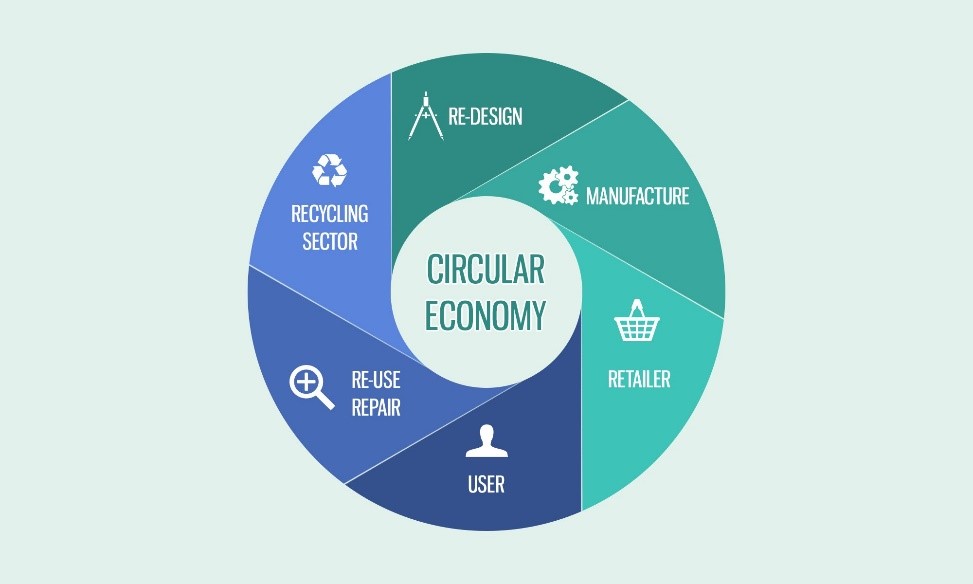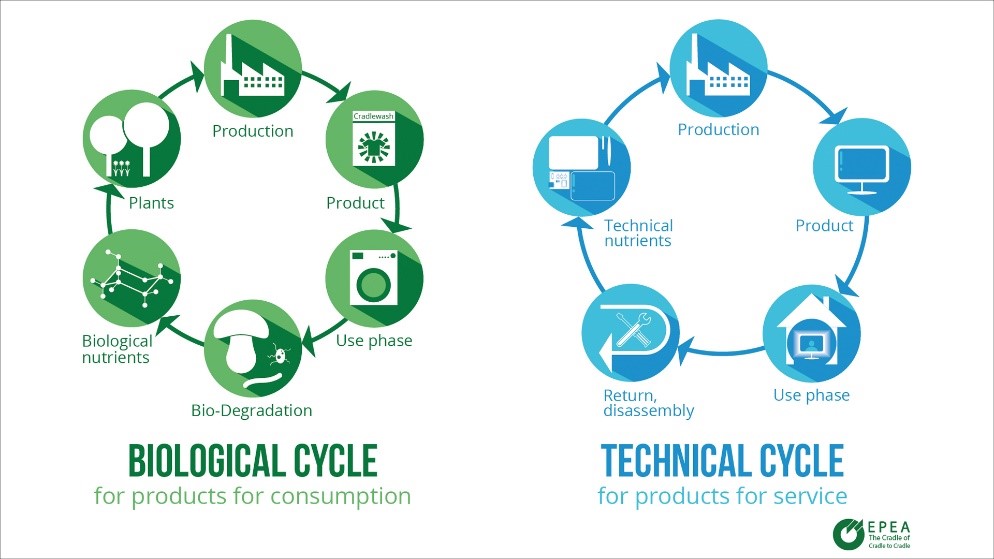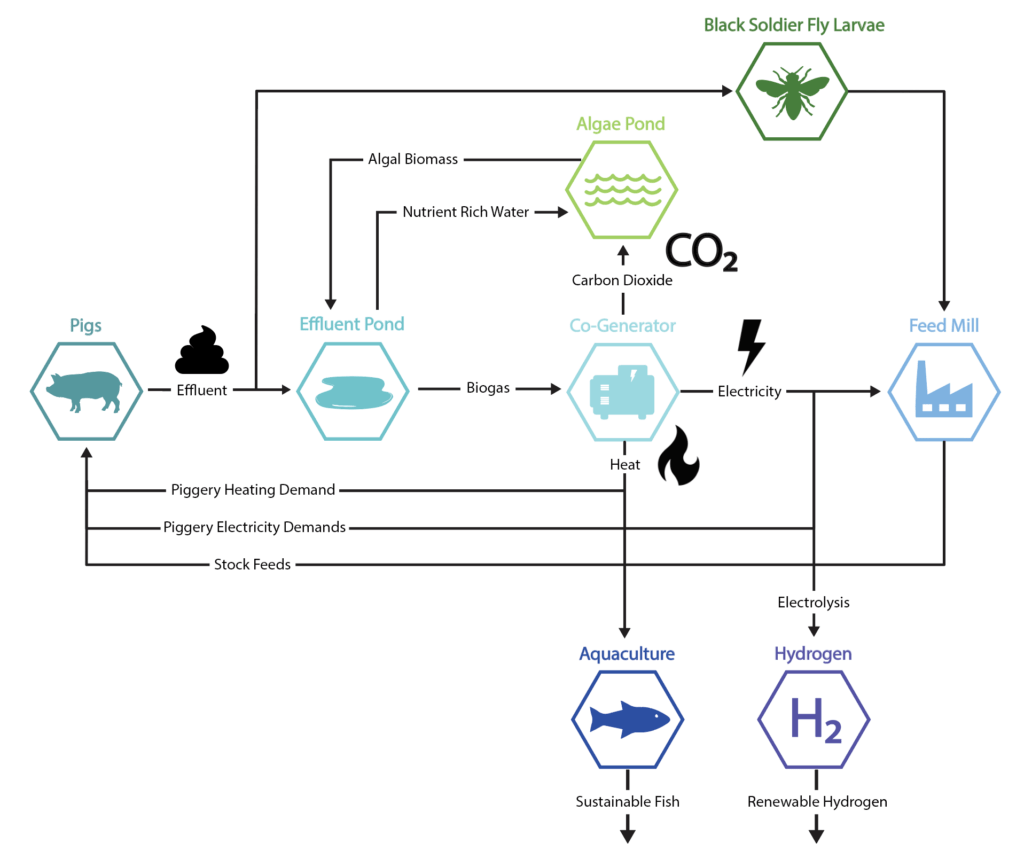Story by Rebecca Craine and Vivienne Wells
—
What is the Circular Economy?
As the global population increases and becomes more developed and urbanised, demand for food, energy and water are rising [1]. However, the Earth’s resources are finite and have a limited capacity to meet this growing demand. The standard model of society today is a linear economy, where resources flow in one direction from their extraction to producers, consumer and finally disposal. Globally, around 90 billion tonnes of primary resources are extracted and used each year, with less than 10 percent being recycled [2]. This has negative impacts on both the environment and human health and such large-scale consumption of finite resources is not commercially sustainable [3]. This issue is only intensified by the environmental stress and uncertainty created by climate change on our food and water resources [1]. To slow this depletion of our natural resources and reduce the environmental damage incurred in their extraction, there is a need to rethink the way society consumes resources. This can be achieved through a shift in the economy away from current methods of “take-make-waste” economy towards one more focussed on reuse and recycling.
The circular economy is an economic model that has gained significant interest in recent decades. It seeks to tackle many of the world’s current sustainability challenges by separating economic growth from consumption [4]. In a circular economy, value chains are closed loops, whereby materials originally intended for disposal are reused, recycled, or reprocessed through the economy [4]. In doing so, new value can be created from products previously thought of as waste, minimising resource input and reducing waste and emissions. Development of a circular economy can also provide value through the creation of new industries and jobs. The circular economy is based on the key principals of keeping products and materials in use, designing waste and pollution out of the system, and regenerating natural systems [4].

In the circular economy model, materials are divided into two categories: technical materials and biological materials.
Biological materials are those that can be safely returned to the natural environment at the end of their use life such as food, wood, or natural fibres. In a circular economy any consumables are made of biological materials, which can be returned to the biosphere and biodegrade over time to return nutrients to the environment [6].
Technical materials cannot be returned to the natural environment and unlike biological materials which can be considered consumable, technical materials cannot be consumed or returned to the biosphere [6]. This requires a shift in the role of the individual from a “consumer” to a “user”. Technical materials must be designed to be durable and reusable or easily upgradeable. This means they can be repeatedly cycled through the economy, continually creating further value [4]. To support this, technical products can be rented or leased, rather than owned, encouraging maintenance and repair, and discouraging disposal [6]. For products where this is not possible, incentives can be created to ensure the return and reuse of the product at the end of its use life.

To support a circular economy system, the energy used to fuel these cycles should also be renewable to reduce resource consumption and environmental impact [4].
One example of how this is being successfully implemented around the world already is through industrial symbiosis, in the city of Kalundborg, Denmark [8]. In industrial symbiosis, waste including energy, water, and materials from one industrial site can be sold on to a nearby site for use as a primary input [9]. In this system, 12 different companies share the products of 20 resource streams to gain mutual benefit [8]. For example, excess steam from electricity production is shared to nearby facilities for process heating and cleaning, and to heat nearby housing. This saves the region money, resources, and reduces their environmental impact.
—
Challenges to the Circular Economy
With so much benefit to a circular economy, it may be difficult to understand why we are still living in a predominantly linear one. There are, however, a number of challenges in achieving a circular economy in the world we currently live in.
One key barrier is the convenience of waste. Food, drink, and other products are often packaged in plastics or other single use materials. To avoid this packaging, the responsibility is currently on the individual to carry and reuse their own bags and bottles or find retailers that use more sustainable packaging [10]. Similarly, it is difficult for suppliers to regain access to their products at their end of life. Where bigger ticket items like electronics and machinery lend themselves well to leasing or sharing models, many companies rely on incentives or customer goodwill to return their products after use [11].
Another challenge is the cost that can be associated with collecting and reprocessing products. After purchase, products can end up in homes or workplaces across the globe. In order to process or recycle end-of-life products efficiently, they must be collected and returned to centralised locations, which can incur difficulty and cost [11]. Complex products such as electronics can also be difficult to separate and to process back into raw materials or components, with a potential loss of quality in the recycling process [11]. These costs can pose particular challenges when the value of the reclaimed materials are less than the costs incurred in collecting and processing them.
Models such as renting, refurbishing and incentive for return can help support shift in consumer habits of waste. Consumer sentiment and government policy can also help to incentivise organisations to establish more circular-economy focussed practices [10].
—
Circular Economy in Agriculture
Agriculture has major impacts on the environment, being a leading contributor to greenhouse gas emissions, water consumption and nitrate and ammonia pollution [12]. Climate change is also expected to have significant adverse effects on agriculture [12]. The circular economy can be applied to agriculture to reduce the impacts of the industry and continue to feed the growing global population. Circularising agriculture is based on the principles of minimising demands on external inputs, closing nutrient loops, and reducing the environmental impact from discharges and runoff [13].

Organic waste from farming has long been used as a source of fertiliser for agriculture. Biological waste such as crop stalks, leaves and pods, and animal waste can be converted into fertilisers which are rich in nitrogen, phosphorous, potassium and other nutrients and can reduce the cost and resource demand for external inputs of synthetic fertilisers [15]. Cities, towns, and agricultural activities such as animal production and irrigation runoff create wastewater, which if treated properly, can also be reused for pastures and plant production [13]. This is not only valuable as a source of water, but it can also contain the same valuable nutrients found in biological waste that act as fertilisers [13].
Biomass from plant and animal waste can also be used directly or modified to produce biofuels that can be used for heat, electricity, or transportation fuel production [15]. Biomass as an energy source is abundant and versatile and can reduce reliance on fossil fuels and waste to landfill.
Reducing waste and increasing efficiency in agriculture can also help to support the circular economy. Precision agriculture can help to do this by using research, remote sensing and data collection to ensure that just the right amounts of substances are used at the right time in exactly the right place [16]. This reduces the resource inputs required and their environmental impact.
Concepts of the circular economy are already being successfully applied in agricultural practices. One example is a farm in Uganda, which has developed a small-scale mixed farming system where a range of livestock and plants are grown on the farm, so waste products can be shared and reused within the system to provide fertilisers, pesticides and energy [17]. Livestock waste is fed to maggots which can be used as feed for fish and other animals, with the insects’ waste and nutrient-rich wastewater from the aquaculture system used to fertilise and irrigate crops [18]. An anaerobic digester is also used to process livestock waste to make biogas for cooking [18]. This farm aims to emulate natural processes by integrating livestock and crop production to allow systems to make use of other’s waste and reduce environmental impact, as well as to generate multiple income streams, improving the farms environmental and economic sustainability.
There are a number of Australian companies also implementing concepts of the circular economy in their business. A Canberra business, GoTerra is using insects including black soldier fly larvae to process food waste into protein and fertiliser, instead of letting it go to landfill. The protein generated by the larvae can be used in pet food and fish and livestock feed, as a lower impact source of protein. The waste products created by the insects are also being used as a nutrient rich organic fertiliser to improve soil quality and resilience.
Implementation of the circular economy is still in its infancy, however there is potential for even more comprehensive integration of circular economic practices in agriculture. One example of where this can be implemented in pork farming where waste products can be reused and repurposed in a range of applications to minimise waste and external inputs in the farming system. Engineering students at the ANU have been working on analysis of these systems since 2020, with the hope of seeing them implemented in focus farms in the near future.
Biogas from pig effluent can be used to meet energy and heat demands of a piggery using a biogas co-generator. But this generates more heat and electricity than most piggeries use, leaving excess electricity and heat which can be used in other applications. The electricity can be used in hydrogen electrolysis and excess heat used in aquaculture, allowing the site to generate renewable hydrogen and sustainable fish products as an additional income stream for their business. Excess CO2 from the generator and effluent can be used in algal ponds to create additional biomass for the effluent ponds, increasing their efficiency in waste conversion and producing more energy for commercial use. These algal ponds could also utilise the wastewater from the pig effluent and aquaculture systems, harvesting their nutrients without risk of runoff into nearby waterways. Another possible use for the effluent waste is feeding black soldier fly larvae using GoTerra’s modular systems to generate feed for the piggery and reduce variable costs of production and external feed input.

Systems such as these can be implemented in piggeries as well as in other agricultural systems to close the loop on waste, generate additional income streams and improve the sustainability of agricultural practice. Looking forward, adoption of circular economic practices has great potential to close the loop on waste and enable society to meet increasing demands whilst limiting environmental damage and resource consumption. Many challenges remain in both the technology and consumer practice that must be overcome before a circular economy can be fully realised. Whether it be in agriculture or other parts of the economy, new technologies and systems that help close the loop on waste are in development and gaining interest, furthering progress towards a more sustainable, circular economy.
—
References
[1] PricewaterhouseCoopers, “Megatrends Climate change and resource scarcity,” PwC. https://www.pwc.co.uk/issues/megatrends/climate-change-and-resource-scarcity.html (accessed Nov. 19, 2021).
[2] B. Oberle, S. Bringezu, S. Hatfield-Dodds, S. Hellweg, H. Schandl, and J. Clement, “Global Resources Outlook,” International Resource Panel, Dec. 2018. Accessed: Aug. 21, 2021. [Online]. Available: https://www.resourcepanel.org/reports/global-resources-outlook
[3] CSIRO, “Circular Economy and Waste Management,” CSIRO. https://www.csiro.au/en/research/environmental-impacts/sustainability/circular-economy (accessed Aug. 20, 2021).
[4] Ellen MacArthur Foundation, “The Circular Economy In Detail,” Ellen MacArthur Foundation, 2017. https://archive.ellenmacarthurfoundation.org/explore/the-circular-economy-in-detail (accessed Aug. 20, 2021).
[5] A. Artiach, “On The Circular Economy, The Environment & The People,” Medium, Jan. 20, 2020. https://sustainabilityx.co/on-circular-economy-the-environment-and-the-people-5459d724ab36 (accessed Aug. 21, 2021).
[6] World Economic Forum, “From linear to circular—Accelerating a proven concept,” Towards the circular economy. http://wef.ch/1CSDVE6 (accessed Aug. 20, 2021).
[7] Sustainable Planet, “Is the UK doing enough on the circular economy?,” Innovation News Network, May 16, 2019. https://www.innovationnewsnetwork.com/is-the-uk-doing-enough-on-the-circular-economy/630/ (accessed Aug. 21, 2021).
[8] “EXPLORE THE KALUNDBORG SYMBIOSIS,” Kalundborg Symbiose –. http://www.symbiosis.dk/en/ (accessed Nov. 19, 2021).
[9] “A good example of Industrial Symbiosis,” Symbiotic Networks of Bio-Waste Sustainable Management. https://symbiosisproject.eu/a-good-example-of-industrial-symbiosis/ (accessed Nov. 19, 2021).
[10] M. Stanislaus, “Barriers to a Circular Economy: 5 Reasons the World Wastes So Much Stuff (and Why It’s Not Just the Consumer’s Fault),” World Resources Institute, May 24, 2018. Accessed: Aug. 21, 2021. [Online]. Available: https://www.wri.org/insights/barriers-circular-economy-5-reasons-world-wastes-so-much-stuff-and-why-its-not-just
[11] B. McCrea, “Four Challenges Standing in the Way of a Circular Economy,” Source Today, Sep. 28, 2020. https://www.sourcetoday.com/supply-chain/article/21142961/four-challenges-standing-in-the-way-of-a-circular-economy (accessed Aug. 21, 2021).
[12] “The future of food and agriculture: trends and challenges,” Food and Agriculture Organization of the United Nations, Rome, 2017.
[13] Food and Agriculture Organization of the United Nations, “Circular Economy: Waste-to-Resource & COVID-19,” Food and Agriculture Organization of the United Nations. http://www.fao.org/land-water/overview/covid19/circular/en/ (accessed Aug. 21, 2021).
[14] Agrocycle, “The Project,” Agrocycle. http://www.agrocycle.eu/ (accessed Aug. 21, 2021).
[15] Landini, “What benefits can the circular economy bring to agriculture?,” Landini, Sep. 24, 2020. https://www.landini.it/au/what-benefits-can-the-circular-economy-bring-to-agriculture/ (accessed Aug. 21, 2021).
[16] Marte Rusten, Anne Louise Koefoed, and Bente Pretlove, “Circularity in Agriculture,” DNV. https://www.dnv.com/to2030/CH_Page/Default (accessed Aug. 21, 2021).
[17] admin, “Outstanding Smallholder Farmer and Eminent Agricultural Policy Advocate share 2019 Africa Food Prize | Africa Food Prize,” Sep. 04, 2019. https://africafoodprize.org/outstanding-smallholder-farmer-and-eminent-agricultural-policy-advocate-share-2019-africa-food-prize/ (accessed Nov. 19, 2021).
[18] “How to run a profitable circular farm: one-acre farm.” https://ellenmacarthurfoundation.org/circular-examples/one-acre-farm (accessed Nov. 19, 2021).
